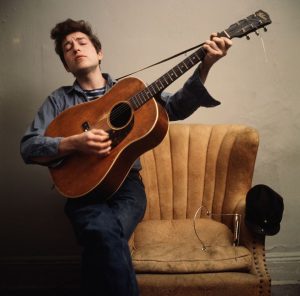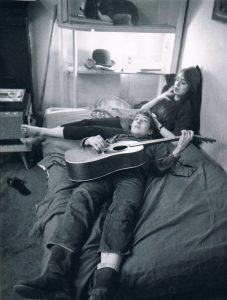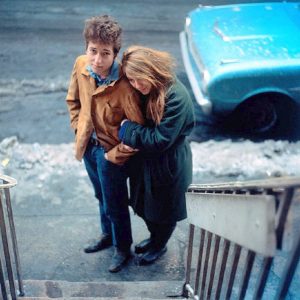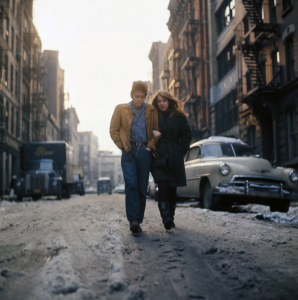by Patrick Roefflaer
This is the fourth article in our series on the artwork on Bob Dylan’s albums. An index to the earlier articles can be found below, and in the index above, “Album artwork”
- Released: May 27, 1963
- Photographer: Don Hunstein
- Liner notes: Nat Hentoff
- Art-director: John Berg
The photo session
 For the art work of Dylan’s second album, the same combination of the Columbia Records staff team was commissioned as for the sleeve his debut album: photographer Don Hunstein and art-director John Berg.
For the art work of Dylan’s second album, the same combination of the Columbia Records staff team was commissioned as for the sleeve his debut album: photographer Don Hunstein and art-director John Berg.
However while for the eponymous album Don Hunstein used a photo studio, this time he decided to try a different location. “I met Bob at his apartment”, he recalled, “which was a third floor walk-up on West 4th Street in Greenwich Village.”
The young folksinger had moved into his first rented apartment in mid-December, 1961, shortly after recording his first album for Columbia.
 Hunstein snapped away while Dylan smoked cigarettes, played his guitar on his bed, and tried on a number of different hats.
Hunstein snapped away while Dylan smoked cigarettes, played his guitar on his bed, and tried on a number of different hats.
In some of the pictures, Dylan can be seen with his girlfriend, Suze Rotolo. A few weeks before the photo shoot, she had returned from Italy and had moved in with him.
In 2008 she told Terry Gross for NPR (National Public Radio) that it wasn’t planned that she would appear in the shoot: “It was all very casual, and the apartment was very small, and the photographer came and the publicity guy from Columbia came.
 So then they started – figured they’d start taking some pictures in the apartment of Bob sitting around, pick up your guitar, put it down, sing something. And then he said – Don Hunstein said to me, get in some of the pictures. So I did. And he took more pictures.
So then they started – figured they’d start taking some pictures in the apartment of Bob sitting around, pick up your guitar, put it down, sing something. And then he said – Don Hunstein said to me, get in some of the pictures. So I did. And he took more pictures.
“And then he said let’s go outside and walk.”
 It is February 1963. A New York cold winter day. “It was freezing outside”, recalled Suze, “I had on a couple of sweaters. The last one was his, a big bulky knit sweater because the apartment was cold and I threw on a coat on top. So I always look at that picture as I feel like an Italian sausage because I had so many layers on, and he was freezing and I was freezing and had more clothes on. It was very cold that day.”
It is February 1963. A New York cold winter day. “It was freezing outside”, recalled Suze, “I had on a couple of sweaters. The last one was his, a big bulky knit sweater because the apartment was cold and I threw on a coat on top. So I always look at that picture as I feel like an Italian sausage because I had so many layers on, and he was freezing and I was freezing and had more clothes on. It was very cold that day.”
She adds: “In some out-takes it’s obvious that we were freezing; certainly Bob was, in that thin jacket. But image was all.”
“It was winter, dirty snow on the ground…”, the photographer told The New York Times in 1997, “Well, I can’t tell you why I did it, but I said, Just walk up and down the street. There wasn’t very much thought to it. It was late afternoon — you can tell that the sun was low behind them. It must have been pretty uncomfortable, out there in the slush.”
“Well, I can’t tell you why I did it, but I said, Just walk up and down the street. There wasn’t very much thought to it. It was late afternoon — you can tell that the sun was low behind them. It must have been pretty uncomfortable, out there in the slush.”
Hunstein had to work fast. “[T]he light was fading so quickly that I was able to shoot only one color roll and a few black and whites. We were lucky to get what got we got,” he concluded.
The sleeve
From the pile of photos, Dylan chose one with a strong resemblance with an iconic portrait of his idol James Dean, made by Dennis Stock in 1954. The star right in the center, with the perspective lines of the cars and the buildings that meet somewhere far away behind him.
It is a beautiful photo: a moment frozen in time. A fresh-faced Dylan, freezing in the icy weather, has his hands thrust deep into his pockets, while Suze Rotolo hangs on his arm. You can almost hear the snow crackle under the feet of the loving couple, together forever in Manhattan in the early sixties.
It is an iconic cover, much imitated and parodied. “It is one of those milestones that influenced the appearance of other album covers, precisely because of the nonchalance and spontaneity,” Suze wrote in her memoirs. A bit mysterious too. “Most album covers were carefully staged and controlled, to terrific effect on the Blue Note jazz album covers… and to not-so great-effect on the perfectly posed and clean-cut pop and folk albums.”
 But it’s more than a beautiful picture: “Maybe no one would ever have understood what those songs were about if the cover hadn’t been around it”, Suze said. “You know, the story is in the songs. Every song he ever wrote about me. It’s all in there. ”
But it’s more than a beautiful picture: “Maybe no one would ever have understood what those songs were about if the cover hadn’t been around it”, Suze said. “You know, the story is in the songs. Every song he ever wrote about me. It’s all in there. ”
Dee Anne Schroeder, who had been married to Don Hunstein for more than 50 years, looked back in 2007: “An awful lot of people know that picture and didn’t connect it with Don’s name. I think that the album cover does give him credit…but people never paid much attention to album cover photos (or)…the photographers.
“That still remains one of the most popular pictures and a lot of people want it. A lot of people write the story, what that picture means to them. They say, yes, it brings back part of their youth. Even young people today, they look back, it says to them: here are these young people walking…in the middle of a harsh environment. It has become a kind of symbol of youth starting off in a harsh environment, but with hope for the future.”
John Berg didn’t have to add much: the title in green and the name of the singer in red, plus the logo in the upper left corner and the songs titles in black listed on both sides of the young couple.
There’s no black and white portrait on the back. Only liner notes. These are by The Village Voice columnist Nat Hentoff. In June 1963, a larger part of the conversations he had with Dylan, was published in Playboy (for those who bought the magazine for the articles) as “Folk, Folkum and the New Citybilly”.
Some interesting titbits:
The Freewheelin’ Bob Dylan was rejected as the title o f his debut album.
f his debut album.
In France The Freewheelin’ Bob Dylan appeared as En roue libre. When discussing the cover of his book Chronicles, Vol. One (Simon and Schuster, October 2004), Dylan wanted a photo of New York as it looked when he arrived. A photograph of Times Square, from 1961 was chosen from New York City 1960’s (Spring Books 1962).
The photographer?
Don Hunstein
Previously in this series…
The untold story of the artwork on Bob Dylan’s Greatest Hits
The Sleeve Art of Bob Dylan’s album: “Bob Dylan”
The Sleeve Art of Bob Dylan’s Album: Slow Train Coming
